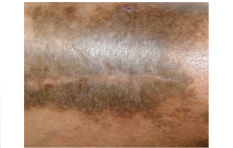







Hypermelanosis from minocycline therapy for acne
Contact with certain drugs, substances, and chemicals can lead to cutaneous depigmentation. A wide variety of drugs and substances has been reported to induce hyperpigmentation, including antibiotics, nonsteroidal anti-inflammatory drugs chemotherapeutics, antineoplastic agents, heavy metals, antiepileptic medications and derivatives of phenol and catechols.
Diffuse muddy brown discolorations in sun-exposed areas of the skin (type III reaction) induced by minocyclin, a tetracycline-derivative, are well documented side-effects presumably resulting from increased melanin production by minocyclin-stimulated melanocytes that can lead, among other things, to deposits of melanin or minocyclin/melanin-complexes at the epidermal basal membrane and in the dermis.
Chemotherapeutics such as bleomycin, daunorubicin, doxorubicin, cyclophosphamide and 5-fluoruracil are able to cause hyperpigmentation, supposedly by stimulation of melanogenesis via direct toxic effects on melanocytes, although the underlying mechanisms are unknown. Based on the observation that fragments of nucleic acids can stimulate melanin synthesis, chemotherapy-induced damage to DNA in skin cells could induce signals that promote melanogenesis.
Heavy metals such as gold, silver, mercury, arsenic or bismuth can enhance melanin synthesis. It is believed that such metals complex with sulfhydryl compounds in the skin that normally block TYR activity and thus resulting in the stimulation of melanogenesis.
Antiepileptic drugs (e.g. hydantoins) are also known to increase pigmentation and might do so by a direct stimulatory action on melanocytes.
Tricyclic antidepressants (desipramine and imipramine) are associated with slate-gray pigmentation in sun-exposed areas caused both by increased melanin in the dermis as well as by electron-dense inclusions within dermal cells.
Antineoplastic agents that have been known to cause hyperpigmentation under certain circumstances include Dacarbazine (Dtic-Dome), Fluorouracil (Adrucil), Methotrexate, Vinblastine (Velban).
Antibiotics may cause phototoxic reactions that can lead to hyperpigmentation. The most common type is Tetracyclines but it can also include Ceftazidime (Fortaz), Fluoroquinolones, Griseofulvin (Grisactin), Ketoconazole (Nizoral), Nalidixic acid (NegGram), Sulfonamides, , Trimethoprim (Proloprim; also, in Bactrim, Septra).
Other substances associated with hyperpigmentation and phototoxic reactions are Amiodarone (Cordarone), Amitriptyline (Elavil), Busulfan (Myleran), Clofazimine (Lamprene), Nitrogen mustard (topical), Zidovudine (Retrovir) Meclofenamic acid, Bendroflumethiazide (Naturetin), Furosemide (Lasix), Hydrochlorothiazide (Esidrix), Eosin, Fluorescein, Methylene blue, Rose Bengal, Amiodarone (Cordarone), Desipramine (Norpramin), Diltiazem (Cardizem), Fibric acid derivatives, Imipramine (Tofranil), Phenothiazines, Quinidine, Quinine, Sulfite food derivatives, Aspirin, Diflunisal (Dolobid), Porphyrins, Psoralens, Pyrazolidinediones, Coal tar.
>
>
>
>
>
>
>
>
>
>
>
>
>
>
>
>
>
>
>
>
>
>
>
>
>
>
INTRODUCTION
PIGMENTARY DISORDER TYPES
Disorders of
Hyperpigmentation
Disorders of Hypopigmentation
COMMON PIGMENTARY DISORDERS
Age Spots/Liver Spots/Lentigos
Acanthosis Nigricans
Albinism
Cafe-au-Lait Macules
Ephelides (Freckles)
Erythema Dyschromicum Perstans (Ashy Dermatosis)
Familial Racial Periorbital Hyperpigmentation
Idiopathic Guttate Hypomelanosis
Leopard Syndrome
Linea Nigra
Melanoma
Melasma
Nevus (birthmarks/moles)
Parkinsons Disease
Phytophotodermatits
Pityriasis Alba
Poikiloderma of Civatte
Postinflammatory
Hyperpigmentation & Hypopigmantation
Seborrheic Keratoses
Sturge-Weber Syndrome
Substance Induced
Hypermelanosis
Tinea Nigra/Tinea Versicolor/Pityriasis
Versicolor
Vitiligo
Waardenburg Syndrome

<< Previous: Sturge-Weber Syndrome
Next: Tinea Nigra / Tinea Versicolor / Pityriasis Versicolor>>